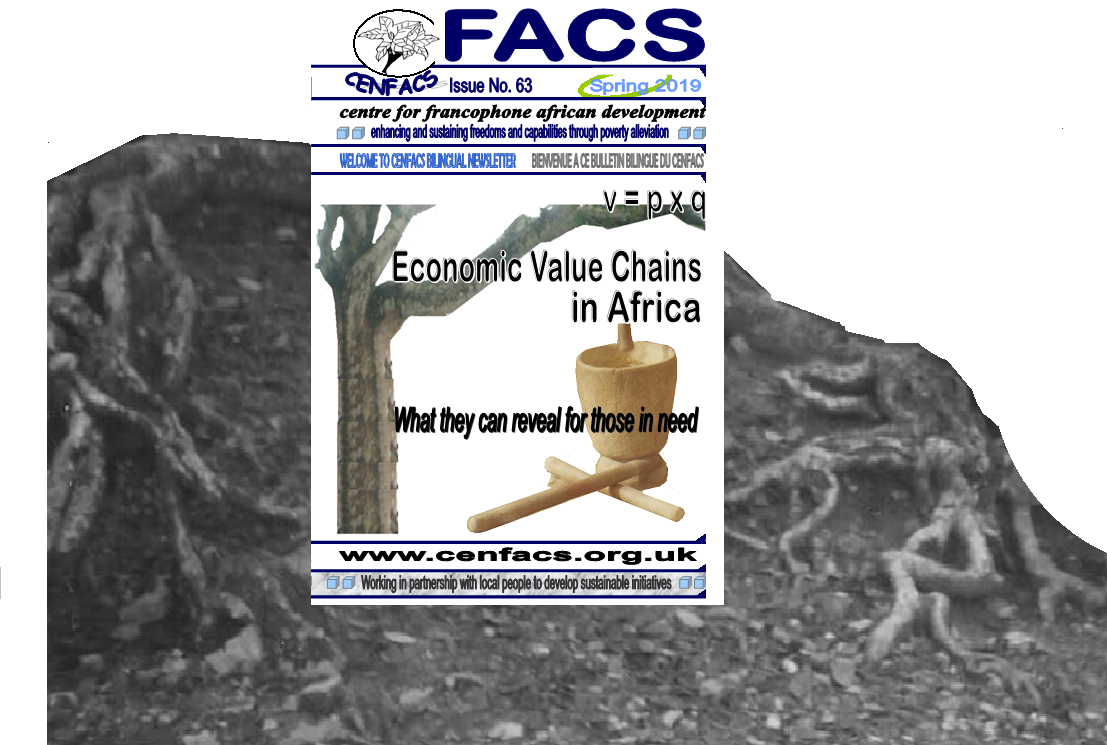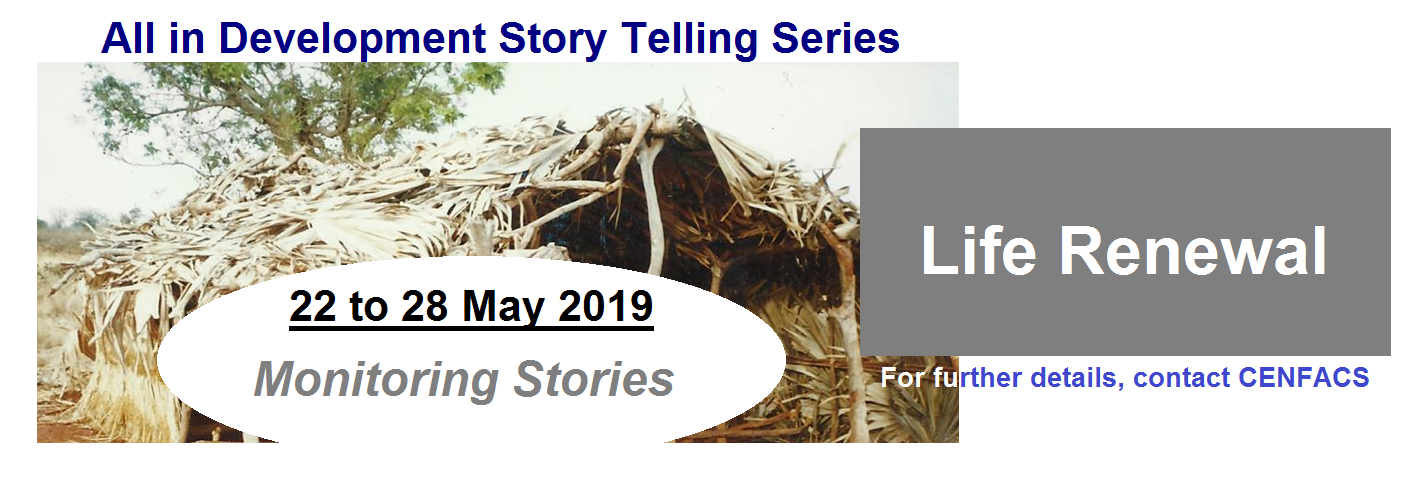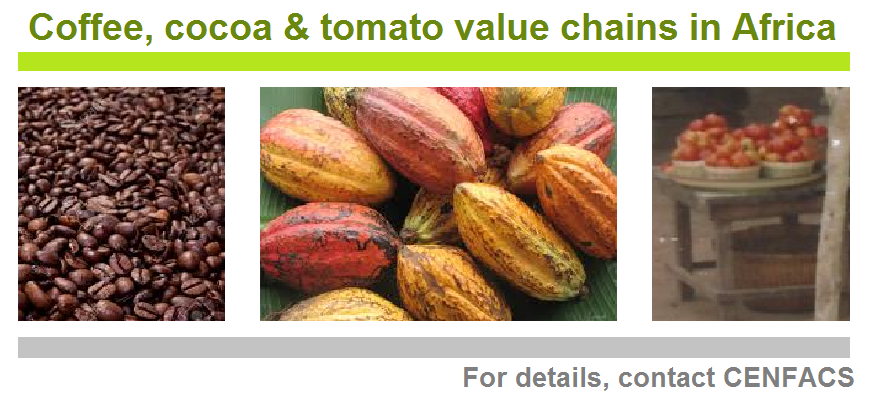Welcome to CENFACS’ Online Diary!
22 May 2019
Post No. 92
The Week’s Contents
• FACS Issue No. 63: Economic Value Chains – What they can reveal for those in need
• All in Development Stories (AiDS) Telling Series, In Focus between 22 and 28 May 2019: Serial No. 4 – Monitoring Stories
• 2020-2063 Follow up (XX236.3F) Programme: Spring 2019 Monitoring
… and much more!
Key Messages
The lead content of this week’s post is Economic Value Chains in Africa, What they can reveal for the poor for those in need. This top content makes the 63rd of FACS.
~ FACS Issue No. 63: Economic Value Chains – What they can reveal for those in need
The issue deals with interlinked economic activities that contribute in bringing a product or a service from conception to final disposal after use. This set of interlinked economic activities contributes to pro-poor initiatives and facilitates better linkages between market players, amongst them African voluntary organisations.. The 63rd Issue aims at looking at what these interlinked economic activities or economic value chains can reveal for the life- sustaining needs of those in most pressing needs.
The Issue discusses the benefits that Africa-based Sister Organisations (ASOs) can gain in diversifying their activities between primary and support ones so that they can add value to their product in the chain as well as create poverty relief value. Their own benefits could be incomplete unless there are gains for the poor and vulnerable people. In this respect, the Issue provides good insight into how poor people and communities can gain from low cost as well as economies of scale and scope that result from organisations engaged in improving their value chains.
Besides these introductory notes to the Issue, the general and key summaries of the 63rd Issue of FACS, which can be found under the Main Development section of this post, shade some lights about this lead content.
~ All in Development Stories (AiDS) Telling Series, In Focus between 22 and 28 May 2019: Serial No. 4 – Monitoring Stories
Before looking monitoring stories, we would like to let you that we are using the definition of monitoring given by Anne Connor in one of the booklets from the Charities Evaluation Services. According to Connor (1),
“monitoring is concerned with systematically collecting and analysing information. It allows us to keep a regular check on what we are doing” (p. 2).
From this perspective, one can tell the stories what they are collected, analysing and checking about life renewal. So, the stories we are dealing with in this serial no.4 are those of:
√ What people (like clients, beneficiaries, etc. ) say about life renewing work
√ Data and information collection
√Data and information analysis
√ Checking performance against objectives
√ Compliance with predetermined standards
√ Regular observation and recording of activities
√ Routinely gathering information on all activities
The issues one can cover in their monitoring story could be …
√ What people or themselves think about for example the recovery process they went through to renew their lives
√ The kinds of renewal needs that have been met and unmet
√ Problems encountered in the renewal process
√ Resources and costs issues related to renewal
√ People involved in the rebuilding story
√ Life renewal activities or projects involved
To donate and or share a story, please contact CENFACS.
(1) Connor, A (1999), Monitoring Ourselves, Illustrated by Steve Simpson, Evaluating Ourselves Series, Charities Evaluation Services, London
~ 2020-2063 Follow up (XX236.3F) Programme; Spring 2019 Monitoring
Monitoring and Evaluation of the Climate Change Reduction, Having Poverty, Sustainable Development Goals and Africa’s Agenda
Because we are talking about monitoring, this week we are also looking at our 2020-2063 Follow up Programme. This is a programme of monitoring and evaluation of aims, goals and targets set up to achieve in the context of climate change reduction (by the Paris Treaty on Climate Change), Having Poverty (by 2011Istanbul Declaration of Least Developed Countries), Sustainable Development Goals and the Agenda 2030 (by the United Nations), and Africa’s Agenda 2063 (by the African Union).
We are taking the opportunity of this week’s monitoring activity to look at the progress made so far regarding the implementation of these global and African goals and agendas as some of them affect our work and are related to the issues we constantly advocate.
To enquire and or donate a story about these four components of our XX236.3 F Programme, please contact CENFACS.
Extra Messages
~ Support Sustainable initiatives in Cong-Brazzaville, Mali and Togo
Our request to support Raped Women in Congo-Brazzaville, Children with Safe Drinking Water in Togo and Young Deaf People in Mali; continues this week as well.
So far, we have received positive reactions which are promising. And we would like to thank those who positively reacted to our support communication. We hope that their reactions will be converted into concrete actions or simply support.
Additionally, on the support page of CENFACS, there are many ways one can support or enhance the lives of those in most need. Please, have a look at http://cenfacs.org.uk/supporting-us/
As we said it last week, we expect this support message to be passed onto those who can help. If you have already passed it, we thank you for your care. If you have not done it, we would be grateful if you could support these deserving causes by passing the message.
CENFACS is prepared to discuss in depth these project proposals.
~ “Quadranscentennial” (Q) Monitoring
Q Monitoring is a king of monitoring activity conducted for a period let say 25 years or more. If one looks at global agendas such as Agenda 2030 (set up for 15 years) and Agenda 2063 (set up for 50 years), having a quadranscentennial view of monitoring for the life span of these agendas could be a good learning and development process.
Monitoring these agendas and getting the monitoring reports and stories behind them on how they are doing in terms of expected outputs, outcomes and impacts; is a good monitoring story to tell and share.
To tell and share your Q monitoring story, please contact CENFACS.
~ AiDS Project: Audio Storytelling, Listening and Short Film Experiences
You can use the capacity of audio to tell your life renewal story. Audio has a proven power and unique quality to convey life renewal messages. You can inform, empower and connect with others using your audio storytelling skills.
Audio storytelling does not demand expensive investment. It is easily accessible to everybody who has at least a smart phone. Audio storytelling (with short digital narratives, podcasting, social media and online streaming) can help create and share the impact of the change you made or have made.
Likewise, you can make short films to support your storytelling experiences and create a social impact. For those who can afford, they can use smart phone filming to create engaging content on a tight budget. Also, you can make film on your smart phone with a video content. Shooting interviews with project participants can also help to create experiences that maximize social media and life renewal contents.
If you have audio storytelling and short films related to life renewal experiences, you can tell and share with us and others. And if you do not mind, we will circulate your stories within the CENFACS Community.
Main Development
• FACS Issue No. 63 > Summaries
• • General summary
The Issue speaks about Economic Value Chains although writers such as Corinna Hawkes and Marie T. Ruel (2) argue that “All value chains inherently involve economic value – a value chain is not a value chain without this.”
The emphasis in the 63rd Issue is on economics as a drive of using available factors of production (i.e. natural resources, labour, capital etc.) as efficiently as possible so as to attain the maximum fulfilment of unlimited demands for poverty relief goods and services.
The goal here is to satisfy the needs of those in conditions of poverty and hardships. However, this economic view does not exclude other values such as social, charitable, voluntary, poverty relief and sustainable development. In fact the Issue talks equally about poverty relief and sustainable development values.
The Issue borrows Porter’s (3) definition of value chains as given in his book “Competitive Advantage”; borrowing it and applying it to the voluntary and charitable sector. If one uses Porter’s definition, it is possible to say that a value is a set of activities that an organisation carries out to create value for its customers. And if this organisation is from the charitable sector, it would create value for its beneficiaries.
In this respect the Issue no. 63 uses the value chain approach as poverty relief and sustainable development strategies to enhance the lives of Africa-based Sister Organisations and poor people. This is how the Issue can help understand what economic value chains can reveal for the poor.
To get a good understanding on what economic value chains can achieve or reveal for the poor, please read the following page summaries.
(2) Hawkes, C & Ruel, M. T. (2011), Value Chains for Nutrition (Chap. 9), International Food Policy Research Institute, Washington, D.C.
(3) Porter, M. E. (1985), Competitive Advantage: Creating and Sustaining Superior Performance.
• • Page Summaries
The 63rd Issue deals with ten areas of interest by Africa-based Sister Organisations in creating and developing value chains which include: integration, skills development, contribution towards pro-poor life, infrastructures and logistics, finances, transaction costs, dynamism of links, value for consumers, participation, and poverty relief and sustainable values.
Let’s now see the page summaries making the body of this Issue.
Page 2
The development of industrial poverty relief services to reduce poverty within the context of economic value chains
Dealing with raw materials, natural resources, finished components and equipment provided by local industries and local organisations’ small scale industries is good. However, poverty relief and sustainable development values can be added to services linked to industries’ products. This concerns many products ranging from foods, healthcare, clothes etc. Examples of these services include coffee and cocoa value chains in Eastern Democratic Republic of Congo.
How diversification can help to reduce poverty and hardships
Diversification is the process of expanding into a range of different product areas. One-market organisation can be very vulnerable to any threats. A concentric or pure or revenue-raising diversification helps to spread risks, reorient activities, entry to new non areas of service and broaden service-providing potentials, while enabling survival in the market dominated by big organisations. If Africa-based Sister Organisations diversify their activities they can expand their ability to help reduce poverty.
How to accelerate pace and extend poverty relief work through value chains
Every organisation has its own pace and rhythm of growing and expanding. This depends on their brand and the market they are in or would like to enter. However, they can improve their speed and extend in terms of poverty relief work through value chains. To do that the starting point would be to develop value chain plan and strategy that can lead to outlets or market openings. An example of this kind of high value domestic chains is the value chains for bananas in Central Africa
Page 3
Economic integration of rural farmers through domestic value chains
Scaling down the economic barriers between rural farmers and with the various players of the rural and not-for-profit economy can create good value and enormously benefit rural farmers. Rural farmers especially those engaged in cash crops production can reap of the benefits of economies of scale and scope while creating value for their beneficiaries. To facilitate this integration, food value chains for small holder farmers can used to improve their margins and cope with agricultural food price volatility.
Acquisition of new operational skills by small and poor traders
Developing your activities in order to create value for your customers could mean for small and poor traders that you possess the skills and competences needed to stay and grow in domestic value chains. Like big organisations, small and poor traders can acquire the skills they need to operate and run their activities. These are the operational and functional skills such as sale, production, management, accounts and administrative skills. Sustained training of farmers for example can help them to gain these skills.
Page 4
Economic value chain niches for African organisations in need
African organisations in need of a good amount of money or price that buyers are prepared to pay for their goods and or services, they will look for parts of market they can target and achieve their goals or meet their needs. If economic value chains can offer them that possibility, they may decide or force to enter this market niche or segment. But to do that, they need to analyse their value chains into market segmentation, potential to add value and strategy on activities.
Experiences and lessons from value chains in the voluntary and community sectors in Africa
The voluntary and community sector organisations in Africa do create value like other organisations, although they may not use value chain analysis. They may not systematically separate their activities into primary and support, nor break down their value chains like we have seen somewhere else like in the UK. For example, in the UK there are organisations which focus on primary activities regarding the running of day-to-day organisation while leaving to their appointed organisation to source out or deal with enquiries and other aspects of their social media accounts.
Value chain approach is part of voluntary sector strategy. Ranging activities between a/ primary value chain which includes inbound logistics, operations, outbound logistics, marketing and sales, and service; and b/ secondary value chain made of procurement, human resource management, technology development and infrastructure; is value-creating. Perhaps, if voluntary organisations can identify those activities they would to undertake themselves and leave those ones they want to source out.
Value Chains Experience Questionnaire
As part this work on what value chains can reveal for the poor, we are running a questionnaire to complete this work on the experiences and lessons from value chains in the voluntary and community sectors in Africa. Those African organisations that are interested in providing their views, we would be pleased to question them.
For any enquiry or interest about this questionnaire, please contact CENFACS.
Page 5
Chaînes de valeurs et consommateurs africains
Cet article essaie d’appréhender les chaînes des valeurs du point de vue de consommateurs et acheteurs plutôt que de celui de producteurs et vendeurs. Les acheteurs et consommateurs pauvres et ceux de revenu faible en Afrique comme ailleurs sont à la recherche des produits (biens et services) de meilleure qualité et/ou à des prix relativement bas (ou compétitifs) et maximisant leur satisfaction. Parfois, ils en trouvent, parfois ils n’en trouvent pas.
Les offreurs et vendeurs de ces produits s’ils montent des chaînes de valeurs, cela peut leur permettre de réduire des coûts de transaction, de réaliser des économies d’échelle et d’envergure. Cela pourra avoir, par ricochet, un effet sur des produits à offrir.
En adoptant une hypothèse de travail selon laquelle que si les prix ou coûts baissent en raison de l’application ou l’appartenance à des chaînes de valeurs, les valeurs ainsi créées ne peuvent être durables que si elles arrivent à satisfaire les besoins des consommateurs. En prolongeant cette assertion, on peut dire que les chaînes de valeurs peuvent permettre de remplir les demandes et besoins des consommateurs pauvres.
Ce schéma semble simpliste et réducteur. Néanmoins, il faut affirmer que pour que la valeur consommatrice se réalise, il ne faut pas qu’il y ait de concurrence déloyale et de menaces des groupes géants dans l’industrie où l’organisation ou les chaînes de valeurs vont se réaliser. Par contre, cela nécessite le soutien des autorités locales en créant un cadre incitatif et la protection de consommateurs ayant des revenus plus faibles.
Page 6
Les chaînes de valeurs économiques, de réduction de la pauvreté et du développement durable en Afrique
La réduction de la pauvreté en Afrique est passée et continue de passer par plusieurs moyens. Ces moyens incluent l’augmentation de revenus ou salaires, la création des emplois, l’octroi des subventions à la consommation ou les politiques régulatrices de relance de la consommation, la réduction des taxes, l’éducation, l’amélioration de projets ou des communautés d’intégration économique régionale etc.
Parmi ces moyens, il y a aussi des chaînes de valeurs économiques. Celles-ci sont un ensemble d’activités qu’une organisation peut entreprendre opérant dans un secteur spécifique afin de délivrer un bien ou service ayant une certaine valeur économique. Cette valeur économique est réalisée par le prix à payer pour une certaine quantité (v = p x q). C’est une valeur que l’on dégage par l’allocation des ressources rares pour satisfaire des besoins et désires humains illimités. Mais, la valeur n’est pas et ne peut pas être seulement économique.
Au-delà de cette valeur purement économique, il y a aussi la valeur de réduction de la pauvreté et celle du développement durable. Pour que des chaînes de valeurs soient utiles en Afrique, elles doivent être aussi et surtout celles de la réduction de la pauvreté et du développement durable. La chaîne de valeur de réduction de pauvreté est celle de réduction de l’état d’une personne qui manque de moyens matériels, d’argent et de ressources. La chaîne de valeur du développement durable celle qui intègre une harmonie dans la réalisation des besoins de la génération d’aujourd’hui et celle du demain. Cette dernière chaîne créerait des ressources énergétiques renouvelables, demanderait la transition énergétique et éviterait le gaspillage des ressources surtout non renouvelables.
En gros, il ne faut pas seulement avoir des chaînes de valeurs économiques au sens strict. Dans la création de valeurs, il y a aussi de valeurs de réduction de la pauvreté et du développement durable. Ces dernières valeurs sont surtout celles dont les gens ont besoin et qu’elles demandent.
Page 7
Dynamics of links for the supply chain to create and strengthen value chains
To create and strengthen value chains, the links need to be logical, orderly and coordinated so that a momentum is created between the various activities making the value chains. . It means that the interplay of the forces causing or creating value is well done in the different processes before the product or service reaches the final consumer or end beneficiary.
How Africa-based Sister Organisations can develop their value chain capacities
They can do it through
<> In-house preparation in laying value chain foundations or structures
<> Training to acquire the value chain skills they need or skills to develop value chains
<> Funding to support the move to value chain policy
<> Commitment while being part of value chain organisations
<> Being part of decision making process of matters related to value chains development
<> Acquisition of stake in the value chain ventures
Page 8
How value chains can contribute towards pro-poor initiatives in Africa
Pro-poor initiatives are the types of enterprises that help to reduce the state of having little or no money and few or no material possessions. They are undertaken to deal with poverty and hardships.
Economic value chains can contribute towards these initiatives by offering solutions or services be it marketing solutions or outreach or distribution of products or communications or branding or sale or financial remedies etc
What African value chain experiences can reveal for the poor
Value chain experiences in African countries and organisations which tried to create them can show that where costs of supply for products have been reduced for value crating organisations, this can benefit these organisations. Likewise, the benefits of this reduction of costs can be passed to end users or project beneficiaries.
Value chain experiences can reveal as well that some other needs could have been met if these countries and organisations are value chain achievers or achieving ones. These needs could include: access to sustainable energy, digital education, healthcare, housing, food etc. For example, value chain approaches are being used to enhance the livelihoods of food producers. Value chains can drive food prices down, which can be beneficial to poor consumers. So, moving a product or service from supplier to customers or end users (supply chain) while adding value along the chain is part and parcel of African organisations.
Page 9
Promotion of infrastructures to create domestic value chains
By infrastructures, we mean the basic structures of small and poor traders and Africa-based Sister Organisations. We also take into account the facilities, services and equipment they can access to run their organisations. They finally need local infrastructures to function as organisations. These local infrastructures include roads, transport systems, factories, schools, hospitals and so on, that could be their potential market.
Promoting the structures of these organisations engaged or to be engaged in value chain strategies of the services they offer in the environment they are, can enable then to create domestic and economic values.
Reducing transaction costs to create effective value chains
To be able to move goods from their places of production, storage to the market where the final consumers are, it means the cost of transportation should be affordable by those who sell for the poor people and communities. Transaction costs (that are comprised of transport, handling, storage and penetration into high value chains) should be affordable. So, reducing transaction costs can help to create effective value chains.
Page 10
Skills development to embrace and survive economic value chains or Skills for Value Chains (Skvach) project
The aim of Skills for Value Chains (Skvach) is to reduce poverty linked to poor or incomplete skills, knowledge, information and capacities amongst African organisations and those who are running these organisations living in deprived areas and anxious improve their skills in order to enable them to meet the poverty relief challenges of their users and beneficiaries while developing themselves. This project will be achieved through a number of activities including training, adult education, supporting information, workshops etc.
Access to financing to develop value chains in the voluntary sector
Finance for voluntary organisations that are trying to creation value is always a headache for small and medium-sized ones. Small and medium-sized organisations have two disadvantages: perception of the voluntary value and financiers’ preferences.
Being a voluntary or charitable organisation is not always seen by some people as a way of creating and adding value to the service or goods they need.
Failing to raise voluntary donations for a small and medium-sized voluntary or charitable organisation could mean they may be subject to market lending terms and conditions. Often those terms and conditions may conflict with voluntary rules and the voluntary value or just not affordable.
However, if there are soft financial schemes, they can access them and enable them to create value for their beneficiaries. Likewise, if they put together their assets and finances they can form a common financial front to help each other to create value chains.
For a paper copy and or enquiry about this Issue, contact CENFACS.
FOR ONLY £1, YOU CAN SUPPORT CENFACS AND CENFACS’ PROJECTS, JUST GO TO http://cenfacs.org.uk/supporting-us/
Thank you for visiting CENFACS website and reading this post.
Thank you as well to those who made or make comments about our weekly posts.
We look forward to receiving your regular visits and continuing support throughout 2019.
With many thanks






